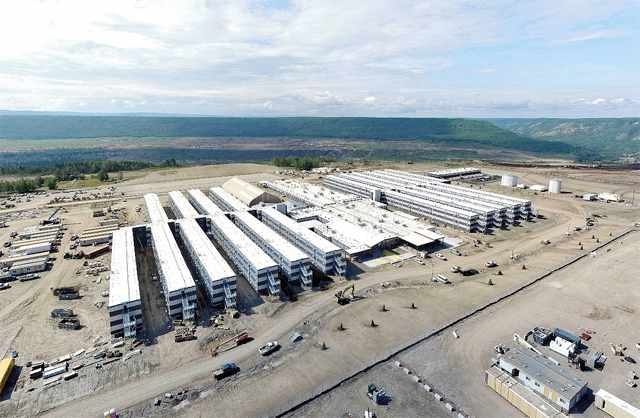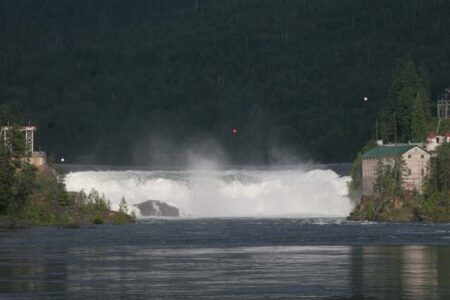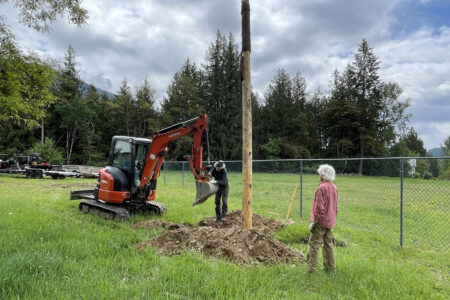Site C construction reaches one-year milestone
Construction of the Site C project in northeast British Columbia reached its one-year anniversary last week. Significant construction progress has been made over the past year and the project is on track for schedule, scope and budget.
“Site C will provide British Columbia with a generational opportunity to secure a reliable source of clean, renewable and affordable electricity for the future,” said Premier Christy Clark. “The construction of Site C is also providing economic benefits today — employing more than 1,000 B.C. workers, offering skills training opportunities for young workers, and providing opportunities for businesses of all sizes.”
Site C will help meet future electricity needs by providing 1,100 megawatts of dependable capacity, and producing about 5,100 gigawatt hours of energy each year — enough to power the equivalent of 450,000 homes per year.
“Site C is a key component of our long-term plan to keep rates down by choosing the least expensive generation option available,” said Bill Bennett, Minister of Energy and Mines. “Like our heritage hydro assets, Site C will also maintain B.C.’s commitment to renewable electricity.”
The latest employment statistics for the Site C project show that there were 1,547 total workers on the Site C project in May 2016, with 1,223 workers from British Columbia (79%) including carpenters, truck drivers, crane operators, safety advisors and officers, general labourers, heavy-equipment operators, mechanics, electricians, worker accommodation lodge operations staff, construction supervisors, environmental workers, engineering consultants and office staff.
In May 2016, there were a total of 107 apprentices working on the project in a range of trades including carpenter apprentices, electricians, plumbers and floor-covering installers.
Site C is also bringing significant opportunities for small, medium and large businesses in the Peace region and throughout the province. To date, over 200 B.C. companies have been involved in Site C construction, either as contractors, subcontractors or suppliers.
Construction of Site C has reached its one-year anniversary. Site C provides economic benefits by employing more than 1,000 BCers, including apprentices working on the project in a range of trades, including: carpenter apprentices, electricians, plumbers and floor-covering installers.
Construction of the Site C project in northeast British Columbia reached its one-year anniversary last week. Significant construction progress has been made over the past year and the project is on track for schedule, scope and budget.
“Site C will provide British Columbia with a generational opportunity to secure a reliable source of clean, renewable and affordable electricity for the future,” said Premier Christy Clark.
“The construction of Site C is also providing economic benefits today — employing more than 1,000 B.C. workers, offering skills training opportunities for young workers, and providing opportunities for businesses of all sizes.”
Site C will help meet future electricity needs by providing 1,100 megawatts of dependable capacity, and producing about 5,100 gigawatt hours of energy each year — enough to power the equivalent of 450,000 homes per year.
“Site C is a key component of our long-term plan to keep rates down by choosing the least expensive generation option available,” said Bill Bennett, Minister of Energy and Mines.
“Like our heritage hydro assets, Site C will also maintain B.C.’s commitment to renewable electricity.”
The latest employment statistics for the Site C project show that there were 1,547 total workers on the Site C project in May 2016, with 1,223 workers from British Columbia (79%) including carpenters, truck drivers, crane operators, safety advisors and officers, general labourers, heavy-equipment operators, mechanics, electricians, worker accommodation lodge operations staff, construction supervisors, environmental workers, engineering consultants and office staff.
In May 2016, there were a total of 107 apprentices working on the project in a range of trades including carpenter apprentices, electricians, plumbers and floor-covering installers.
Site C is also bringing significant opportunities for small, medium and large businesses in the Peace region and throughout the province. To date, over 200 B.C. companies have been involved in Site C construction, either as contractors, subcontractors or suppliers.
“In the northeast, the slowdown in the natural resource sector has been significant and the construction of Site C is providing employment and business opportunities at a time when it is really needed,” said Mike Bernier, MLA for Peace River South.
“There are hundreds of workers from the Peace region working on Site C and that’s very good news,” said Pat Pimm, MLA for Peace River North.
“In addition to construction, I’m also pleased that community agreements are in place with the City of Fort St. John, the District of Taylor and the District of Chetwynd, and good progress is being made on a framework to manage a $20 million agriculture compensation fund.”
In the first year of Site C construction, BC Hydro has implemented community-benefit measures including new childcare spaces, funding for a range of non-profit organizations and for emergency and transitional housing programs, affordable housing units, support for agriculture, enhanced road safety along Highway 97 and support for emergency planning.
BC Hydro has been consulting and engaging with Aboriginal groups about Site C since 2007 and continues to have many positive discussions with Aboriginal groups affected by Site C.
Offers of accommodation have been made to all of the First Nations significantly affected by the project and BC Hydro is committed to working hard with Aboriginal groups to address their concerns and identify opportunities for them to benefit from the project.
BC Hydro has reached agreements, or terms for agreements, with a number of Aboriginal groups, including Dene Tha’ First Nation and McLeod Lake Indian Band.
In July 2016, BC Hydro and McLeod Lake Indian Band reached agreements that will provide economic development opportunities and other benefits related to the construction and operation of Site C. The agreements, which were endorsed in a vote by band members, include an impact benefits agreement, a contracting agreement, as well as a tripartite lands agreement, to which the Province is also a party.
To date, there has been significant involvement of Aboriginal businesses in site preparation work, including security services, clearing, and road and bridge construction. So far, BC Hydro has $130 million in procurement commitments to Aboriginal companies. There are expected to be further Aboriginal contract and job opportunities going forward.
“We’re building Site C to meet the long-term energy and capacity needs of our customers,” said Jessica McDonald, president and CEO of BC Hydro.
“We’ve made very good progress after our first year of construction, including schedule, budget and safety.”
The Site C Clean Energy Project is a hydroelectric dam and generating station under construction in northeast British Columbia. Once complete in 2024, the project will provide clean, reliable and cost-effective electricity for more than 100 years.
Key highlights of the first year of Site C construction include:
- The project surpassed 1,000 B.C. workers in May 2016. The latest job figures show 1,223 British Columbians working on the project — that’s 79% of the current workforce (1,547).
- Over 200 B.C. companies have been involved in Site C construction, either as contractors, sub-contractors or suppliers.
- 1,200 rooms and key amenities are now available for Site C construction workers after completing the first two phases of the worker accommodation lodge – that’s 75% of the 1,600 rooms required.
- Approximately 2.5 million cubic metres of material has been excavated and relocated on the north bank of the dam site. That’s enough material to fill about 1,000 Olympic-size swimming pools.
- Over 900 hectares of land has been cleared as part of site preparation work. That’s roughly the size of 850 baseball fields.
- More than 65,000 cubic metres of timber has been delivered to local mills in Fort St. John for processing.
- The 329-metre Peace River construction bridge was completed on time and on budget in March 2016, linking the north and south banks of the dam site.
- Public road improvements to 240 Road (1.6 km) and 269 Road (0.9 km) are substantially complete, with upgrades to Old Fort Road (5.6 km) and 271 Road (3.0 km) underway.
- The main civil works contractor, Peace River Hydro Partners, mobilized to site in spring of this year and started physical work in June.
- To date, BC Hydro has signed contracts and made financial commitments of more than $4 billion.


























